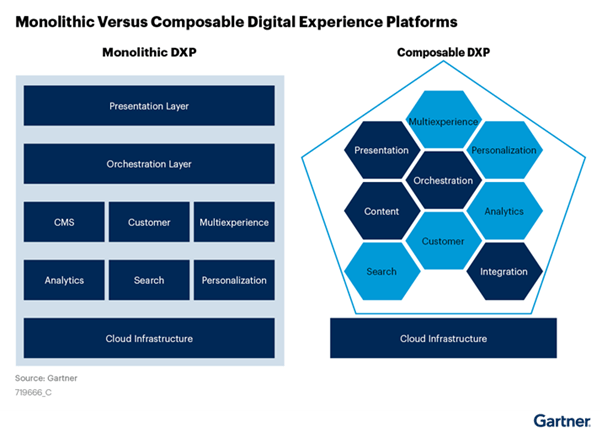Composable commerce is a new-age welcome shift from the traditional monolithic ecommerce in retail space. Rather than having a one-size fits all solution, composable ecommerce brings in modularity and flexibility to add features as you scale in line with you per your business requirements.
According to Gartner, Composable Commerce is using packaged business capabilities (PBC) with the aim of future-proofing all digital commerce experiences.
What is Composable Commerce?
Composable commerce is a term that refers to the use of modular, reusable components to create custom online shopping experiences for customers. This can include everything from the way products are presented and organized on a website to the way customers can interact with and purchase those products. The goal of composable commerce is to make it easier for businesses to create and customize their online stores, and to provide customers with a more personalized and seamless shopping experience.

Composable commerce is a concept that refers to the ability to build and customize online stores and other e-commerce platforms using various modular components, or “composable,” that can be easily combined and arranged to create a unique and functional shopping experience. The idea is to give merchants and store owners more flexibility and control over the design and functionality of their online stores. It uses a mix of modern day commerce technologies such as MACH (Microservices, API, Cloud, Headless) and JAMstack (JavaScript, APIs and Markup) to help the brands to create a more tailored and personalized shopping experience for their customers.
Some of the key features of composable commerce platforms include the ability to :
– Seamlessly add, remove, and rearrange different elements on the storefront, such as product listings, menus, banners, and forms;
– Integrate with a wide range of external tools and services, such as payment gateways, marketing and analytics platforms, and customer relationship management systems; and
– Easily update and maintain the store without the need for specialized technical skills.
How Composable Commerce is Beneficial for Online Retailers?
There are several potential benefits of composable commerce for online retailers. Some of these benefits include:
Increased flexibility: Composable commerce platforms allow retailers to easily customize and rearrange the different elements of their online stores, giving them more control over the design and functionality of their storefronts. This can help retailers create a more personalized shopping experience for their customers and stand out from their competitors.
Reduced time and costs: Composable commerce platforms can help reduce the time and costs associated with building and maintaining an online store. Because retailers can use pre-built, modular components to create their store, they don’t need to start from scratch or hire specialized developers to make changes.
Improved scalability: With composable commerce, retailers can easily add new features and integrations to their online stores as their business grows and evolves. This can help them scale their business more efficiently and effectively.
Enhanced customer experience: By allowing retailers to customize their online stores to better meet the needs and preferences of their customers, composable commerce platforms can help improve the overall shopping experience and drive customer loyalty.
Increased sales: By providing a more tailored and personalized shopping experience, composable commerce platforms can help retailers increase their sales and revenue.
What is the Difference Between Composable Commerce & Headless Commerce?
Now that we have familiarised with the concept of Composable commerce, the next thing you would be asking is how is Composable commerce different from headless commerce? After all, headless commerce also focuses on a modular style of ecommerce development !
In reality, both are two approaches to building and managing e-commerce platforms that share some similarities, but there are also some important differences between the two.
Composable commerce refers to the ability to build and customize online stores using various modular components, or “composables,” that can be easily combined and arranged to create a unique and functional shopping experience. The focus is on providing merchants and store owners with more flexibility and control over the design and functionality of their online stores.
Headless commerce, on the other hand, refers to an architecture in which the front-end user interface (UI) of an e-commerce platform is decoupled from the back-end systems that manage the core business logic and data. This allows retailers to use any type of front-end UI, such as a mobile app or a website, to access and interact with their e-commerce platform, without being tied to a specific platform or vendor.
One key difference between composable commerce and headless commerce is that composable commerce focuses on customizing the UI and user experience of an online store, while headless commerce focuses on decoupling the UI from the back-end systems to create a more flexible and scalable e-commerce platform. However, it is possible to combine both approaches and use a headless architecture with composable UI elements to create a highly customizable and flexible e-commerce platform.
Want to know more about ecommerce trends ? Stay tuned to this space as we come up with such interesting ecommerce tech articles. If you are seeking answers to some pertinent e-commerce challenges, drop an email at sales@embitel.com for a one-on-one consultation with our digital experts.


